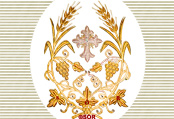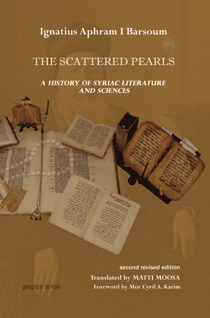
 |
|
||
|
The Scattered Pearls Patriarch Aphram I Barsoum, 1943 (Matti Moosa, trans.) |
Translator's Introduction (Excerpt):The systematic study of Syriac literature and sciences and related subjects was a Western development, beginning in Europe at the end of the seventeenth century. Curiously, the Syrians and other Eastern writers have only recently devoted themselves to the scholarly study of Syriac literature. Even the art of poetry, considered one of the Syrians’ foremost literary achievements, has had only scant attention from Syrian writers. Now lost is a treatment of that subject by Severus bar Shabho, a metropolitan of the Monastery of Mar Matta, near Mosul, Iraq, in the early 13th century. In 1875, Rev. Jabrail Qirdahi published a treatise in Arabic on the meters of Syriac poetry, along with short Personageaphies of some Syrian poets and specimens of their work, but he gave no historical account of its development. In 1986, the Syrian Roman Catholic bishop of Damascus, Monsignor Yusuf Dawood (David), treated the Syrian poetry and prosody in the final chapter of his extensive grammar of the Aramaen language. The Rev. Bulus (Paul) Bahnam, the late Syrian Orthodox Metropolitan of Iraq (d.1969), wrote for his Arabic magazine al-mashriq (1946-53) a series of articles on Syrian culture. In 1949, two Egyptian professors of Semitic studies at the University of Faud I in Cairo published a History of Syriac Literature, an unfortunate work derivative in character and lacking annotation. The first Western study of Syriac literature, by the scholar Eusebe Renaudot, who died in 1720, has been highly praised by J.B. Chabot. This manuscript was never published, however, and was consequently overshadowed by Guiseppe Simone Assemani's four volume Bibliotheca Orientalis, the first volume of which appeared in 1719. Later writers on the subject have been more than slightly indebted to this nearly exhaustive work. William Wright’s A Short History of Syriac Literature (London, 1984) originally appeared in the Encyclopedia Britannica in 1887 and was expanded for its posthumous publication in book form. La Liturature Syriac, by Rubens Duval (Paris 1889) providing a neatly organized, comprehensive history of Syriac literature down to the l3th century. Still another important work, Geschichte der Syrischen Literatur, by Anton Baumstark (Bonn, 1922), presents copious references and notes, but its information seems too compressed for the non-specialist. The second volume of Georg Graf's five-volume Geschichte der Christlichen Arabischen Literatur (Vatican City, 1944-53) is highly valuable for the study of the Syrian Church following the Muslim conquest. The study of Syriac literature, then, originated in the East, but was brought to its fullest development by western writers. As Assemani, an Easterner by birth and tradition, used his important knowledge to shape Westerners’ ideas on Syriac Literature, so today it is the Westerners following his lead who have formulated the views generally accepted in the East. It is against this rather tenuous, uncertain background that Patriarch Barsoum projects his “Unstrung Pearls." “We can justly appraise his historical account only by acknowledging its indebtedness to early scholarship, yet recognizing its uniqueness in an exaggerated nationalistic tone and in an unremitting accumulation of compendious, detailed information. Bishop G.P. Bahnam, in Nalahat al-Khuzam, has given us abundant information on the life of Patriarch Barsoum. Born on June 15, 1887, in Mosul, Iraq, Barsoum received his early education in a private Dominican school, studying French and Turkish as well as religious literature and history; later he learned Arabic under the training of Muslim scholars. At the Za`faran monastery in Mardin, Turkey, where he started his theological training in 1905, he gave himself to the study of the Syriac language and literature. After his ordination as a priest in 1908, he remained at the monastery to teach, and in 1911 he assumed the additional responsibility of managing the monastery press. Later in that year he began a scientific journey to all the monasteries and churches of Mesopotamia and Turkey. Soon after his return in 1913 he made another similar trip to examine the Syriac manuscripts in the great libraries of Europe. On May 20, 1918, Patriarch Elias III named Barsoum bishop of Syria, and after World War I, he gained national recognition not only as a man of religion, but also as a man of learning. He championed the cause of Syrian unity, winning firm popular support by his admonition to the French to regard themselves as liberators rather than conquerors. In 1919, he was chosen to represent the national rights of the Syrian community in the peace settlement at Paris. He was disillusioned, however, by the atmosphere of self-interest which prevailed among the delegates representing the European powers, and at one stage of the conference found himself defending not only the rights of the Syrians, but those of the Arab nations. Though Barsoum did not succeed in protecting the Syrian's interests at Paris, the journey yet gave him ample opportunity for further study of Syriac literature before his return in May, 1920. Two years later, the League of Nations' action making Syria a French mandate brought him the new responsibility of providing for refugees from Cilicia, and he also undertook the building of many new churches in and near Aleppo. Another journey took Barsoum to Geneva and Lausanne as an apostolic delegate to the World Conference on Faith and Order (August 3-21, 1927). Soon afterwards he came as an emissary of the Patriarch to the United States, where he investigated the condition of the Syrian Orthodox Church, consecrated three new churches, and ordained new priests. He also gave lectures on the Syriac language and literature at the Providence University and the University of Chicago, and served at the Oriental Institute of the latter institution until his return in 1929. After the death of Patriarch Elias III in 1932, the Synod of Bishops named Barsoum his acting successor. On January 30, 1933, he was formally elected Patriarch of Antioch, assuming the ecclesiastical name of Mar Ignatius Aphram I Barsoum. The new Patriarch quickly showed himself as an active Church head, establishing new dioceses and founding a theological seminary at Zahla, Lebanon (later moved to Mosul, and then to Beirut), and served as its leader until his death on June 23, 1957. Despite the numerous responsibilities of his work in the Church and frequent interruptions for travel, Barsoum devoted much of his time to writing. Chief among his published works are the following:
Patriarch Barsoum produced many other works which have never been published. His Syriac-Arabic lexicon and his compendium of church history in the 20th century are written in both Syriac and Arabic. His history of Tur Abdin, in Syriac, has been translated into Arabic by Bishop Bahnam. In Arabic, he also wrote a history of the Patriarchs of Antioch and the famous men of the Syrian Church, a history of Syrian dioceses, an index of Syriac manuscripts, and translations of ten liturgies of the Syrian Church. Also, he translated into Arabic the second part of the Ecclesiastical History of Bar `Ebroyo in 1909 when he was a monk at the Monastery of Za`faran. The unique copy of this translation is now in the possession of this editor. Al-Lulu al-Manthur was not, then, the solitary work of an unlearned Eastern Patriarch, but part of the considerable output of a man thoroughly conversant with the subject. What purpose did Barsoum have in writing the book? We may begin to answer this question by considering its title. The French title, Histoire des Sciences et de la Litterature Syriaque, misleadingly suggests that the book resembles the Western studies of Syriac literature. We should prefer the Arabic title, Kitab al-Lulu al-Manthur fi Tarikh al-Ulum wal-Adab al-Suryaniyya ("The Unstrung Pearls of the History of the Syriac Sciences and Literature"), which implies metaphorically that the work aims to present information which lies outside the scope of Western studies. The Introduction, written not only in Arabic but also in French and Syriac, indicates more exactly the nature of the work. Barsoum states that he hopes to fill the existing gaps in the knowledge of Syriac literature, and to pay tribute to the language of the Church. He notes that at the beginning of the present century there commenced a revival of interest in the history of science and literature, but adds that "Aramaean science and literature" have received insufficient treatment from Western writers. Duval, Wright, Baumstark, and Chabot, he says have devoted their attention to what they recognize as "science and literature" in the general sense (but, it is implied, they have passed over the extensive body of sacred literature in Syriac.) Also, Barsoum notes, of these writers only Baumstark gives any consideration to Syriac literature after the end of the thirteenth century. Barsoum proposes to treat here several subjects omitted by earlier writers, including calligraphy, versification, the rites of the Church, geographical sketches of Syrian cities, historical documents, the history of Syriac literature since 1920, and works and manuscripts previously unknown. In another chapter he summarizes the work of those Orientalists who have preserved Syrian culture and criticizes writers who have sought to lessen the influence of the Syrian's knowledge. The immediate audience for which Barsoum writes includes two groups: historiographers and philologists seeking further knowledge of Syriac literature, and the faithful members of the Syrian Church, whose national feeling he hopes "may be reinvigorated in their ancestral spirit." Additional evidence of the restricted audience to which the book appeals lies in the assertion that it "treats only Western Syrian scholars and writers to the exclusion of the Eastern Syrians (Nestorians) and what is known of the meager culture of the Malkites and the Maronites." For Barsoum, the prospect of a fruitful and beneficial "social result," the ressurection of the cultural heritage of the Syriac-speaking community, is full recompense for the difficulties and material expenses of preparing this work, which represents the "fruit of our untiring labor over a period covering nearly a third of a century of our episcopal and patriarchal life." Structurally, the book is divided into three distinct sections. The first, containing thirty-one chapters, concerns the religious literature and other related writings extant in Syriac. After introductory chapters on the Syriac language and literature, and expositions on Syrian centers of learning and libraries, Barsoum treats in detail the Christian literature which has survived, including liturgies, the books of rituals used in the Church, and the lives of great men of the Church. The second part presents Personageaphies of 293 prominent Syrian writers; fixty-six of these have not been previously cited by Western writers. In the third part are appendices giving the names of Syrian calligraphers, meanings of foreign terms in the book, geographical names, lists of monasteries, an index of Personageaphical references, and lists of saints. Judged in terms of its author's stated purpose, al-Lulu al-Manthur must be considered highly successful. In fact, it was received enthusiastically not only by the members of the Syriac-speaking community for whom it was written, but also by the Roman Catholic and Muslim scholars. Viscount Philip de Tarrazi, a Roman Catholic writer, offered this judgment:
|

2nd ed., 2003 ISBN: 1-931956-04-9 |
| Copyright © Syriac Orthodox Resources. All Rights Reserved. |
| Last Update: March 15, 2004 |